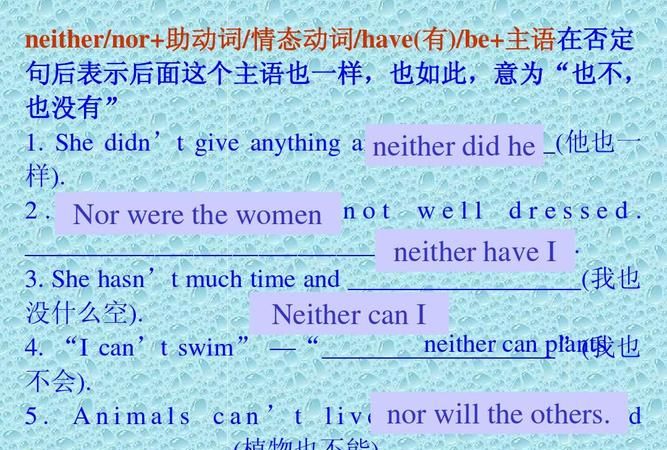本文目录
neithernor的用法及例句
neither...nor...表示"既不……也不……".其含义是否定的,可连接任意两个并列的成份.例如:
She likes neither butter nor cheese.她既不喜欢黄油也不喜欢乳酪.此句中neither...nor...连接两个宾语.当neither...nor...连接两个主语时,也应遵循"就近原则".例如:
Neither dad nor mum is at home today.今天父母都不在家.
若将neither...nor...句型变为肯定句,只需把neither...nor...改为both...and...即可,同时谓语动词必须用复数形式.例如:
Both dad and mum are at home today.今天父母都在家.
还可以单独使用neither作主语,表示"两者中没有一个".例如:
Neither of them likes football.他们俩都不喜欢足球.
neither或nor还有另外一种用法,就是当表达一个人没有做某事,另一个人也没做同一类事时,可用neither或nor进行简略回答,其结构为:Neither / Nor+助动词 / 情态动词 / be动词+主语.例如:
He doesn\'t go to school by bike.Neither / Nor do I.他不是骑自行车上学,我也不是.
They didn\'t go to the park yesterday.Neither / Nor did we.昨天他们没去公园,我们也没去.

neither nor就近原则
展开3全部
neither nor需要采用就近原则。
neither nor 英[ˈnaɪðə(r) nɔː(r)] 美[ˈnaɪðər nɔːr]
[词典] 既不……也不;两者都不;均不;
Neither he nor they are wholly right。
他和他们都不是完全正确的
以靠近谓语动词的、作主语的名词作为人称和数的参考标准,
即谓语动词单复数要参考nor后的主语人称。

扩展资料
neither...nor...表示"既不……也不……",其含义是否定的,可连接任意两个并列的成份。当neither...nor...连接两个主语时,也应遵循"就近原则"。
例如:Neither he nor she is at home today。
今天他和她都不在家。
若将
neither...nor...句型变为肯定句,只需把neither...nor...改为both...and...即可,同时谓语动词必须用复数形式。
a、当主语不是同一个人或物时,nor和neither可互换,当主语是同一个人或物时,只能用
nor。
例如:I don't know,nor do I care,
我不知道,也不关心。
b、当并列分句有两个以上时,只
能用nor。
例如:You can't sing,nor can I,nor can she。
你不会唱歌,我不会,她也不会。
给我举几个例子
展开1全部
neither nor既不...也不...
Neither she nor I knew. 她和我都不知道。
She likes neither butter nor cheese. 她既不喜欢黄油也不喜欢乳酪Neither dad nor mum is at home today. 今天父母都不在家He is neither tall nor short. He is medium height.他不高也不矮,中等个儿。 either or不是...就是...;要么...要么...
She is either drunk or mad. 她不是醉了就是疯了。Many other experts insist this is not an either or situation . 许多其他专家坚持说这不是一个二选一的情况。 When the girl is happy, she either sings or dances. 那个女孩高兴时,不是唱就是跳。 Either you or I am going there tomorrow. 明天要么你去那里,要么我去那里。

neither nor用法
展开3全部
具体Neither nor的用法有以下几种:
1、neither…nor…表示"既不……也不……"。其含义是否定的,可连接任意两个并列的成份。
例如:
He likes neither butter nor cheese.
她既不喜欢黄油也不喜欢乳酪。此句中neither…nor…连接两个宾语。
2、当neither…nor…连接两个主语时,也应遵循"Neither nor就近原则"。就近原则与语法一致原则、意义一致原则并成为主谓一致中三大原则,当就近原则与其它两种原则发生冲突时,应优先考虑其它两种原则。就远原则就是谓语动词的变化即:谓语动词与前面主语一致。
例句:
Neither the students nor the teacher knows anything about it.
学生和老师都不知道这事.
3、若将neither…nor…句型变为肯定句,只需把neither…nor…改为both…and…即可,同时谓语动词必须用复数形式。
例如:
Both dad and mum are at home today. 今天父母都在家。

4、还可以单独使用neither作主语,表示"两者中没有一个"。
例如:
Neither of them likes football.
他们俩都不喜欢足球。
5、neither或nor还有另外一种用法,就是当表达一个人没有做某事,另一个人也没做同一类事时,可用neither或nor进行简略回答,其结构为:Neither / Nor+助动词 / 情态动词 / be动词+主语。
例如:
He doesn't go to school by bike. Neither.
他不是骑自行车上学,我也不是。
扩展资料
neither和nor区别
1、词性不同
neither 可以作为连词、副词、代词,但是nor只能作为连词和副词,不能作为代词。
2、用法不同
neither后可接be动词,且通常可以作为连词使用,而nor不能,通常要搭配neither …nor使用。
以上就是关于neither nor就近原则例句 ,neithernor的用法及例句的全部内容,以及neither nor就近原则例句 的相关内容,希望能够帮到您。

